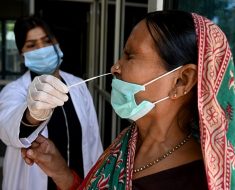
Maintaining strong and healthy bones is usually linked to adequate consumption of calcium. However, vitamin D is also a key factor in bone health. According to Dr. Donald Ford, who specializes in family medicine at Cleveland Clinic, calcium doesn’t get absorbed into the bones without the help of vitamin D. Without the latter, calcium won’t do much to keep your bones strong.
Dr. Ford also says that vitamin D can help prevent osteoporosis, which can make bones brittle. A deficiency in vitamin D can cause a gradual loss of bone strength.
According to Dr. Tania Elliott of NYU Langone, the Institute of Medicine recommends daily consumption of 600 to 1,000 IUs (international units) of vitamin D to meet 95% of what people need. Thankfully, there are plenty of sources for your daily dose of vitamin D.

ESB Professional/Shutterstock | Aside from calcium, vitamin D is also important for bone health.
Sunlight
Sunlight can urge the body to produce vitamin D. However, sun exposure can come with risks of skin cancer. Dr. Stephen Honig, the director of the Osteoporosis Center over at New York City’s Hospital for Joint Diseases, says that 20 to 25 minutes of sun exposure can already help with your vitamin D levels. Although, you have to make sure that your skin is well-protected from the harmful rays of the sun.
You would less likely get vitamin D from sunlight if you’re in high latitudes, it’s wintertime, or if you are older or dark-skinned. Getting sunlight through the window won’t work too.
Fatty Fish
Various types of fish are excellent sources of vitamin D, says Dr. Ford. Just choose the fattier fishes because it contains more of the vitamin. The National Institutes of Health says that just 3 ounces of cooked rainbow trout can give you 645 IUs, while cooked salmon of the same amount provides 570 IUs. Tuna fish, sardines, and cod liver oil are good choices too. Adding more fish to your diet also gets you more omega-3 fatty acids, which are good for your heart health.
Canned Tuna
Aside from fresh fish, you can also get vitamin D from canned ones like tuna and sardines. These are less expensive and have a longer shelf life compared to fresh fish, so you can easily stock up for future uses. Among the canned fishes, canned light tuna has the most vitamin D content with 150 IUs per 4 ounces.

Amarita/Shutterstock | Canned tuna is also a good source of vitamin D.
Fortified Milk
In the U.S., almost all types of cow’s milk are enriched with vitamin D. An 8-ounce glass of milk generally has at least 100 IUs of vitamin D, while 6 ounces of yogurt usually has 80 IUs. The amount of vitamins you can get depends on how much is added. You can also get about the same amount with soy and rice milk variants. Make sure that you check the label since not all of them have vitamin D.
Fortified Orange Juice
If you’re not into dairy, you can still get your dose of vitamin D with fortified orange juice. An 8-ounce glass of OJ usually has vitamin D content of around 100 IUs, but it may vary depending on the brand.
It’s also important to note that not all of these brands are fortified, so better check the label. Two examples of brands that are fortified are Minute Maid Kids+ Orange Juice and Florida Natural Orange Juice. Just 8 ounces of these OJ brands can give you 100 IUs.
Egg Yolks
A convenient way to get vitamin D is to consume eggs. Since the vitamins come from the yolk, it’s recommended to use the entire egg and not just the whites. Since eggs are popular ingredients in a wide variety of recipes, it’s easy to add them to your diet.
However, you should take caution in your consumption as one egg already has 200 mg of cholesterol. That’s a substantial amount considering that the recommended cholesterol consumption by the American Heart Association is not more than 300 mg per day.

iva/Shutterstock | Although eggs have vitamin D content, these also have cholesterol.
Fortified Cereal
Fortified cereal gives your vitamin D with a crunch. Reach for the low-calorie type of fortified cereals—like Multi-Grain Cheerios—to get a portion of your daily fill of vitamin D. Complete your breakfast with fortified milk and a serving of fortified orange juice. You can get 90 IUs for a cup of Multi-Grain Cheerios plus half a cup of fortified milk. You can get around 200 IUs if you also have a glass of OJ.
Some people take supplements to boost their vitamin D intake. However, Dr. Ford says that it’s still a controversy in medicine if supplements are necessary for most people.
Before adding another supplement to your daily routine, consider spending the suggested amount of time under the sun, or supplementing your diet with more fatty fish. You can also consult your primary care provider to check if you’re doing the necessary things to stay healthy or you still need supplements to help you.
Source: Read Full Article





